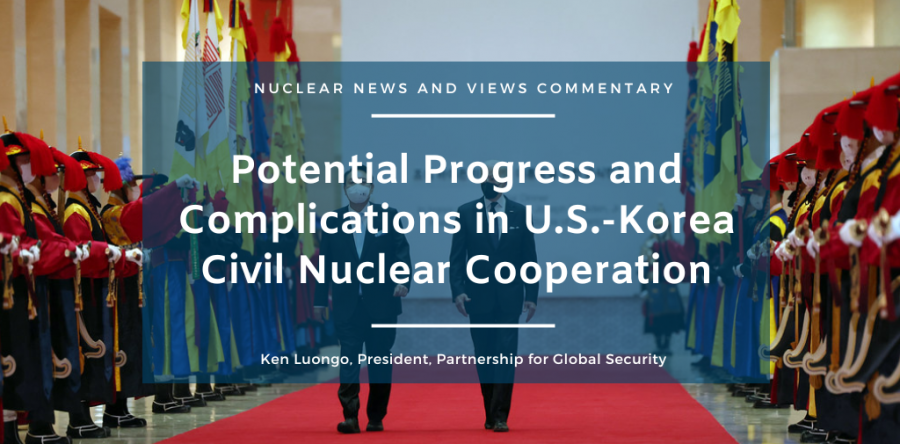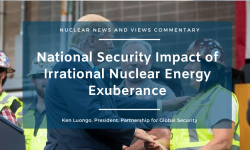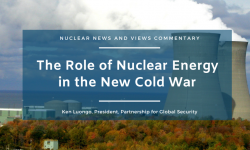The nasty corporate clash between the U.S. and South Korea on civil nuclear relations finally seems to be resolving. But this multi-year disagreement between Westinghouse and KEPCO over the Korean reactor’s intellectual property content and U.S. export controls has altered the nuclear partnership between the two countries and it needs to be rethought.
The October 2022 decision by Westinghouse to file a lawsuit against KEPCO and its parent company KHNP, brought to a head a simmering, intense disagreement between the companies.
The Koreans asserted that their APR-1400 nuclear reactor was free from Westinghouse IP and therefore not subject to U.S. export control requirements. Westinghouse disagreed because the reactor is based on a design from a company it absorbed in a merger.
There now seems to be a concerted effort to settle the issue.
One sign of pending peace is that the U.S. and Korean companies are negotiating toward a mid-March legal resolution of the dispute. If finalized, it likely will favor the American views on the IP and related export control issues while offering substantial financial benefits to the Korean nuclear industry in future deals.
Another important action was the decision of South Korean President, Yoon Suk Yeol, to stay KEPCO’s involvement in bidding for Saudi Arabia’s nuclear reactors. This bid was at the heart of the U.S.-ROK fight.
Because the U.S. does not have a nuclear cooperation agreement with Saudi Arabia, if the Korean reactor export was tied to U.S. approvals it would be held hostage to the U.S.-Saudi nuclear negotiations, which are currently moribund. Without ties to American technology, the reactors could have been exported without U.S. approval.
But even if this fight can finally be finished, it is not likely to end the competition between the two nations for new nuclear markets, and may further complicate their relationship.
One new flashpoint has already emerged in Central and Eastern Europe. The U.S. has worked for decades to cultivate the nuclear market in key countries like Poland and the Czech Republic. But the Korean companies are eager for this business as well.
Late last year, the Polish government selected the Westinghouse AP-1000 for its first three nuclear power plants. And it is investigating the potential role for U.S. small modular reactors.
But on the heels of the AP-1000 announcement, private Polish energy firms confirmed cooperation with KHNP to build the Korean reactor at a separate location. This ignited indignation in Washington and it has intensified the competition between the U.S. and Korean companies for the reactor tender in the Czech Republic.
A driving force behind Korea’s competitive aggressiveness is the commitment of Yoon to expand the role of nuclear power domestically as part of an energy security and zero-carbon strategy, and to export ten Korean nuclear power plants by 2030.
The resolution of the U.S.-Korean nuclear dispute may open the door to KEPCO-Westinghouse cooperation in third countries again and there are clear market opportunities. But the battle has scarred South Korea and the Korean government is hedging its bets against another commercial freeze-out by the Americans.
Central to this strategy seems to be the United Arab Emirates. The UAE is the one nation where the U.S. and Korean companies have cooperated on nuclear reactors in a third country. KEPCO won the reactor bid, but Westinghouse provided billions in content to the four reactors at the Barakah site. The Korean performance in building those reactors has impressed other countries considering nuclear energy.
In January, Yoon travelled to Abu Dhabi and the two nations agreed to “strengthen strategic cooperation in…peaceful nuclear energy” including the development of “export markets for nuclear power plants in third countries [and] evaluating the potential of small modular reactors.” At the end of this trip, the UAE committed to invest $30 billion in Korean industries, including nuclear energy.
The infusion of UAE sovereign wealth money, combined with the Korean government’s generous financial support of its nuclear industry changes the complexion of the U.S.-Korean nuclear competition and the potential for cooperation.
ROK-UAE collaboration on nuclear energy projects in third countries may offer critical advantages in financing guarantees and supply stability that the U.S. government cannot or will not provide. It also provides the Korean companies with a partner with deep ties in the nascent Middle East nuclear market and greater commercial leverage in supplying the next generation of nuclear energy. The Korean SMART small modular reactor already is being commercialized with Saudi Arabia as a partner.
SMRs and advanced reactors are well suited to developing economy nations that have growing populations and economies and that desire firm, clean power sources. It is potentially a significant market that spans from Africa, through the Middle East, to Asia and other regions. A number of these nations are skeptical of American power, so a partnership with the UAE may be commercially advantageous to Korea.
SMRs and advanced reactors do not depend on the same bilateral ties as the large-scale reactors of the past. As a result, the U.S. may not have as much influence over where smaller Korean reactors are sold. That can impact America’s nuclear export ambitions.
It’s clear at this point is that U.S.-Korea civil nuclear relations have been damaged by a prolonged dispute and that it created radiating impacts. What’s needed now is a deep rethinking of the long-term U.S.-Korea nuclear relationship and how it can serve the needs of both nations, including their global clean energy and security goals.
Ken Luongo, President, Partnership for Global Security





